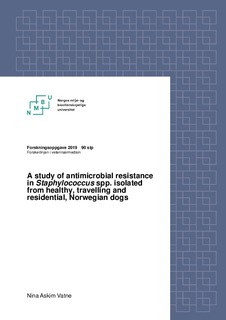| dc.contributor.advisor | Wasteson, Yngvild | |
| dc.contributor.advisor | L´abée-Lund, Trine | |
| dc.contributor.author | Vatne, Nina Askim | |
| dc.date.accessioned | 2019-06-20T12:09:16Z | |
| dc.date.available | 2019-06-20T12:09:16Z | |
| dc.date.issued | 2019 | |
| dc.identifier.uri | http://hdl.handle.net/11250/2601555 | |
| dc.description.abstract | Antimicrobial resistant bacteria are of an increasing concern in both human and veterinary medicine. In this research project, we investigated the occurrence of antimicrobial resistance in species of Staphylococci in different segments of the Norwegian dog population. The work presented in this research essay has a particular emphasis on dogs travelling from abroad to Norway, as well as healthy, Norwegian dogs with no signs of infectious or inflammatory disease. Samples were collected from healthy dogs arriving at the Oslo International Airport in the fall of 2016, and from healthy, residential, Norwegian dogs in the spring of 2017. A total of 72 dogs from abroad were sampled, and 62 residential, Norwegian dogs. From the samples from dogs from abroad, 39 isolates of Staphylococci spp. were collected. From the residential Norwegian dogs, 19 isolates were collected. Methicillin-resistance was not found in any of the isolates, using both phenotypic and genotypic methods. 23% percent of the dogs from abroad were classified as multi-resistant, being resistant to 3 or more antimicrobials, while none of the samples from residential, Norwegian dogs were multi-resistant. Resistance to penicillin and tetracyclines was more prevalent in the residential, Norwegian dogs, than those from abroad. More research is needed to conclude whether travel abroad poses a health risk for the Norwegian dog population. | nb_NO |
| dc.description.abstract | Antibiotikaresistens sees på som en stor trussel for både human- og dyrehelse. I dette
forskningsprosjektet undersøkte vi forekomsten av antibiotikaresistens i stafylokokker i forskjellige segmenter av den norske hundepopulasjonen. I denne forskningsoppgaven er hovedfokus på klinisk friske hunder som reiser til Norge fra utlandet, og norske hunder bosatt i Norge, uten tegn på klinisk sykdom. Prøver ble samlet inn fra hunder som reise til Oslo Lufthavn høsten 2016, fra utlandet, og friske, norske hunder som ikke hadde nylig vært utenlands høsten 2017. 72 hunder fra utlandet ble prøvetatt, og 62 norske hunder. Fra de utenlandske hundene ble det isolert 39 isolater av stafylokokker, mens det fra de norske hundene ble isolert 19. Prøvene ble analysert for antibiotikaresistens ved hjelp av fenotypiske og genotypiske metoder. Ingen meticillinresistens ble påvist. 23% av isolatene fra utlandet ble klassifisert som multiresistente (resistente mot 3 eller flere antibiotikum), mens ingen av de norske isolatene viste multiresistens. Forekomsten av penicillinresistens og tetracyklinresistens var høyere blant de norske isolatene, enn blant de utenlandske. Mer forskning trengs for å konkludere hvorvidt utenlandsreiser og en åpen hundepopulasjon fører til en økt helserisiko for norske hunder. | nb_NO |
| dc.language.iso | eng | nb_NO |
| dc.publisher | Norwegian University of Life Sciences, Ås | nb_NO |
| dc.rights | Attribution-NonCommercial-NoDerivatives 4.0 Internasjonal | * |
| dc.rights.uri | http://creativecommons.org/licenses/by-nc-nd/4.0/deed.no | * |
| dc.title | A study of antimicrobial resistance in Staphylococcus spp. isolated from healthy, travelling and residential, Norwegian dogs | nb_NO |
| dc.title.alternative | Et studie av antibiotikaresistens hos Staphylococcus spp., isolert fra friske norske hunder som reiser til Norge eller bor her | nb_NO |
| dc.type | Student paper, others | nb_NO |
| dc.source.pagenumber | 24 | nb_NO |
| dc.description.localcode | VET-FORSK | |

